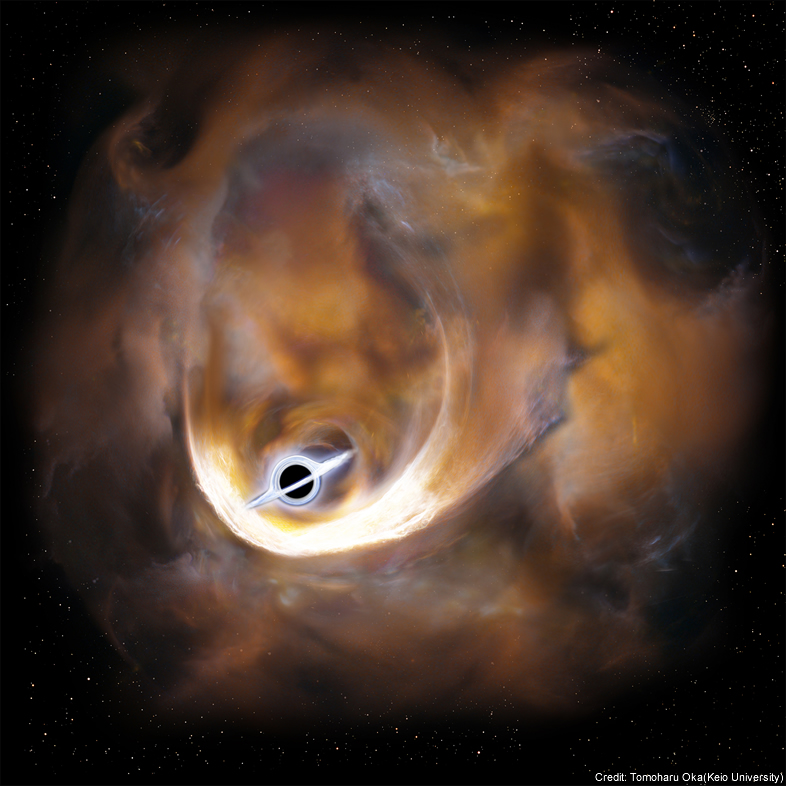Strange Object May Be Milky Way's Second-Largest Black Hole (and a Cosmic Missing Link)

A newly discovered object may be the second-largest black hole in the Milky Way, weighing in at about 100,000 times the mass of the sun.
The dense body would be the first intermediate-mass black hole found in the Milky Way, and it could shed light on how the supermassive black holes lurking at the hearts of perhaps all large galaxies may have formed, the new study's researchers said.
For decades, astronomers have detected either stellar-mass black holes equal in mass to a few suns, or supermassive black holes that have the mass of millions of suns, such as Sagittarius A* at the heart of the Milky Way, which is about 4.5 millions of times the mass of the sun. However, in-between, intermediate-mass black holes have largely eluded discovery.
Scientists think stellar-mass black holes form when giant stars die and collapse in on themselves. However, much remains uncertain about how supermassive black holes got so big; they apparently grew extraordinarily rapidly and appeared early in cosmic history.
One theory holds that supermassive black holes may have formed from intermediate-mass black holes merging at the centers of galaxies. Now, scientists think they may have found an intermediate-mass black hole that's about 195 light-years from the core of the Milky Way.
"This is the first detection of an intermediate-mass black hole candidate in the Milky Way," Tomoharu Oka, a researcher at Keio University in Yokohama, Japan, and lead author on the new study, told Space.com. "This may be the second-largest black hole in the Milky Way after Sagittarius A*."
The researchers investigated a compact cloud of molecular gas about 16 light-years wide, located about 27,000 light-years from Earth. They focused on this cloud, known as CO-0.40-0.22, because it was unusually warm and dense compared to clouds near it.
Get the Space.com Newsletter
Breaking space news, the latest updates on rocket launches, skywatching events and more!
Using the Atacama Large Millimeter/submillimeter Array in Chile, the scientists tracked the motion of gas within the cloud. Their computer simulations suggest these motions can only be explained by the gravitational pull of an intermediate-mass black hole hiding within the cloud.
Oka suggested this intermediate-mass black hole will eventually get pulled into the heart of the Milky Way and merge with Sagittarius A*. "It supports the merging scenario of supermassive black hole formation," he said.
To confirm the nature of this black hole, Oka and his colleagues now plan to observe this cloud in multiple wavelengths of light. They are also investigating other compact clouds of molecular gas that may harbor black holes, Oka said.
The scientists detailed their findings online Sept. 4 in the journal Nature Astronomy.
Follow Charles Q. Choi on Twitter @cqchoi. Follow us @Spacedotcom, Facebook and Google+. Original article on Space.com.
Join our Space Forums to keep talking space on the latest missions, night sky and more! And if you have a news tip, correction or comment, let us know at: community@space.com.

Charles Q. Choi is a contributing writer for Space.com and Live Science. He covers all things human origins and astronomy as well as physics, animals and general science topics. Charles has a Master of Arts degree from the University of Missouri-Columbia, School of Journalism and a Bachelor of Arts degree from the University of South Florida. Charles has visited every continent on Earth, drinking rancid yak butter tea in Lhasa, snorkeling with sea lions in the Galapagos and even climbing an iceberg in Antarctica. Visit him at http://www.sciwriter.us









